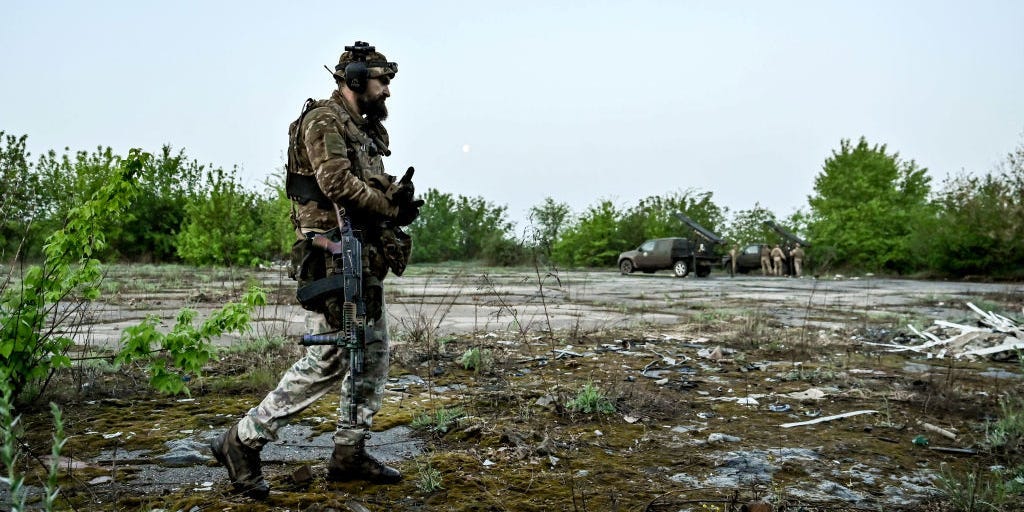The UK donated military equipment to Ukraine that was so old it would have been thrown away, according to a new report from the National Audit Office (NAO) published on Wednesday.
According to the NAO, the UK’s Ministry of Defence “prioritized older items” that were “often due to being scrapped or replaced” after Russia’s invasion of Ukraine began in February 2022.
For example, in March 2022, the UK donated 17,010 pairs of unused army boots that were “nearing the end of their usable life,” the report said.
The equipment donated from UK stockpiles between February 2022 and March 2024 was valued at £171.5 million, or around $224.5 million, it added.
The report added that the UK has committed to donating £7.8 billion, or around $10.2 billion, to Ukraine’s military before March 2025, making it the third largest donor to the country after the US and Germany.
“As the MoD plans its future support, it must continue to balance the UK’s strategic interests with maintaining the UK’s own military capabilities,” Gareth Davies, head of the NAO, said in a statement to Financial Times.
“This includes making sure there are appropriate stocks of equipment and sufficient training provision for UK forces,” he added.
“The war has tested our stockpiles, but it’s a good thing for us that we have cleared out old kit and can now replace it with new equipment,” one unnamed defense official told the FT.
The report estimated that the UK will spend £2.5 million, or around $3.2 million, to replace the donated stockpiles.
It comes against a backdrop of criticism over Western-supplied military equipment to Ukraine.
Ukraine has been receiving military aid from its allies throughout Russia’s full-scale invasion, which started in February 2022.
But Western aid has often come in fits and starts, as Ukraine’s allies debate what and how much to give, leaving soldiers on the front lines struggling with shortages over different periods.
In April, a high-ranking military officer, speaking to Politico, said Ukraine is struggling with weapons from the West because they are no longer a significant match for Russia.
“Often, we just don’t get the weapons systems at the time we need them — they come when they’re no longer relevant,” the officer said.
“Every weapon has its own right time. F-16s were needed in 2023; they won’t be right for 2024,” he said.
In the same NAO report, the impact of military training provided to Ukrainian soldiers from the UK, the Netherlands, Canada, Sweden, Finland, Norway, Denmark, Estonia, Lithuania, New Zealand, Romania, Kosovo, and Australia was investigated.
The various trainings took place in the UK and covered weapon handling, trench fighting, law of armed conflict, urban warfare, live firing practice, and battle inoculation, the report said.
According to self-assessments cited by the NAO, around 89% of people who took the training said that they felt better equipped to survive in the war.
However, others said some elements could be better targeted toward conditions in Ukraine. For example, they said there was a lack of drone training, which the MoD said was due to “military and civil aviation restrictions.”
It added that it was “exploring ways to mitigate the shortfall,” the report said.
“All UK forces have access to the relevant training required to be held at readiness to protect the UK and meet our NATO commitments,” a MoD spokesperson said in a statement to Business Insider.
“But we welcome the NAO’s report, which recognises that Ukrainian troops are better prepared to defend their country from Russia’s illegal invasion thanks to the UK providing training,” they added.
In July, the global military alliance NATO pledged to continue supporting Ukraine with the NATO Security Assistance and Training for Ukraine, or NSATU, a new initiative to coordinate the supply of military aid and training.
It comes as future support from the US remains unclear prior to the election. In April, Congress approved a $61 billion US aid package to Ukraine which had been held up over opposition from far-right Republicans.
“Such a large aid package may be the last this year,” a former Ukrainian officer who operates the Frontelligence Insight newsletter said in comments cited by the Financial Times.
“Moreover, there is a fairly high probability that all subsequent aid packages for Ukraine will be much smaller in size,” they added.
The Ministry of Defence of Ukraine did not immediately respond to a request for comment.
Read the full article here
















